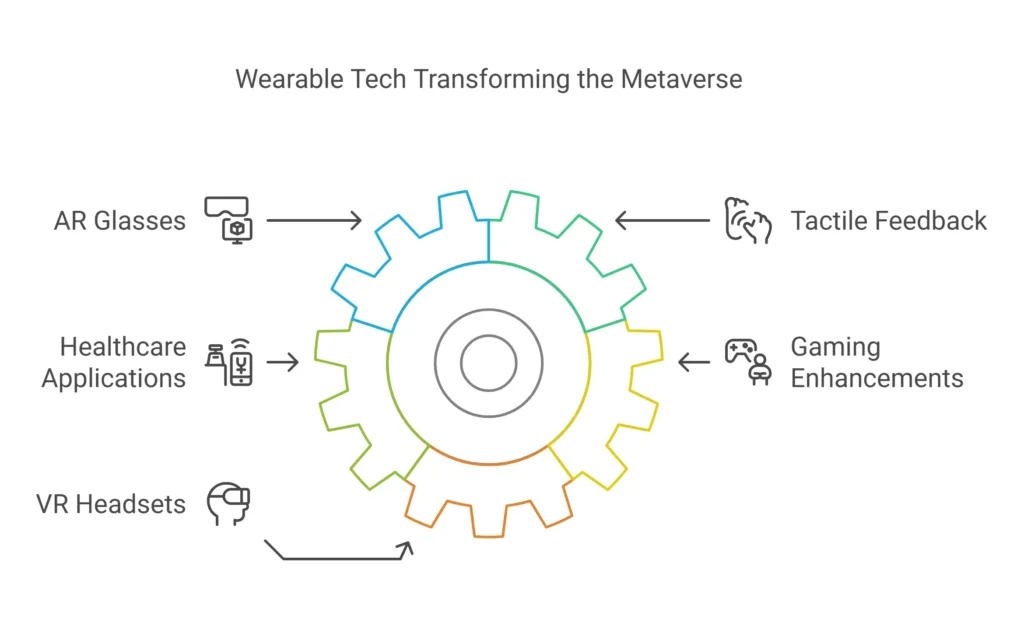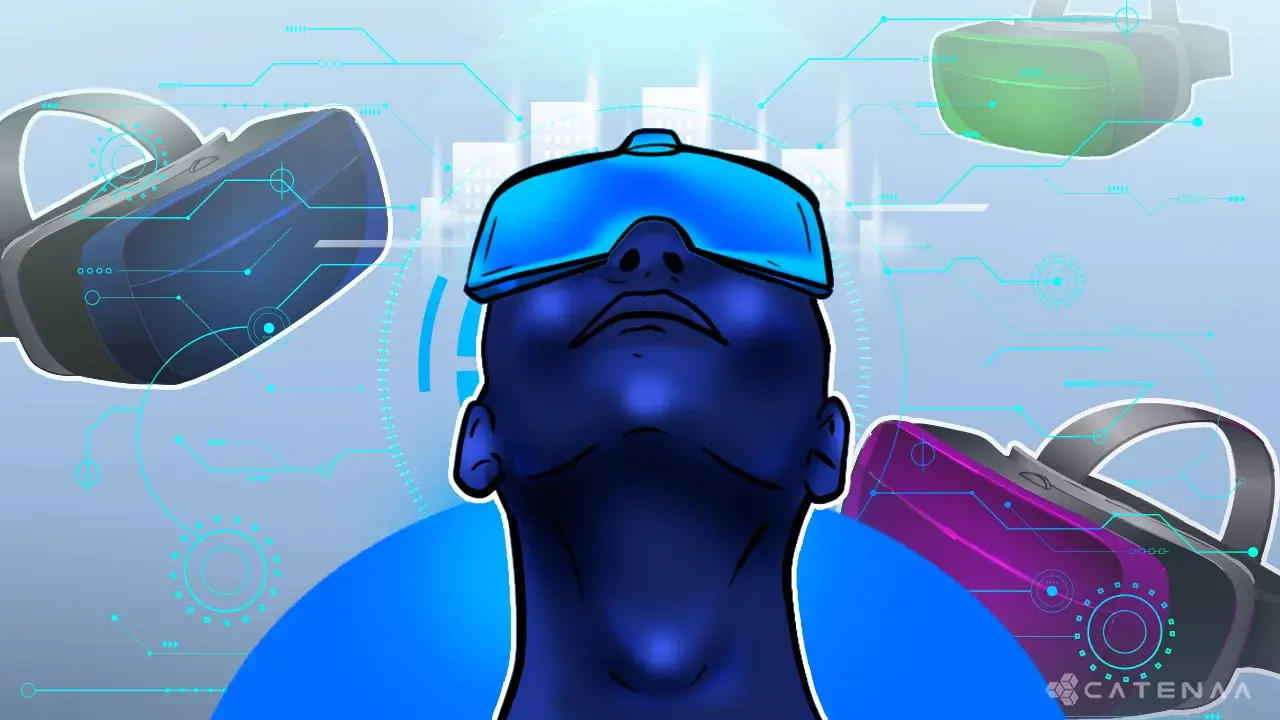Table of Content
How The Next Generation Wearables Would Empower Metaverse
The Metaverse and wearables are two interconnected concepts. These two concepts play a prominent role in the realm of Virtual experiences.
The Metaverse mainly refers to a virtual living space or a digital space where people can interact. Additionally, they can also interact with computer-generated environments in real-time. Its aim is to integrate the physical and virtual worlds seamlessly.
How and where do wearables play a role in this?
Without wearable technology, the Metaverse will be nothing more than an idea. Without a way to bridge the physical and virtual worlds, no one will be able to experience the virtual world. By integrating sensors and haptic feedback, wearables are able to provide users with a realistic and more intuitive experience.
Haptic feedback, basically tactile feedback, provides users with physical sensations or vibrations as a response to their actions or interactions with a device.
It is a way to create a sense of touch in digital and virtual environments, enhancing the user experience and improving interaction with various devices and applications.
And now, the new generation of wearables can provide nonverbal cues and such to convey emotions, which in turn enhances the communication experience.

New immersive wearable technologies have been able to improve the metaverse experience. Devices such as VR headsets, AR glasses, and motion tracking suits have provided users’ of the Metaverse with a more intuitive and almost authentic experience. These wearables also track body movements, gestures, and more, which allows the users to navigate the Metaverse seamlessly and with ease. Incorporating wearable technology has enhanced the immersive experience and blurred the line between the physical and virtual worlds.
How Wearables are Transforming Traditional Industries in the Metaverse
Wearable technology and the Metaverse have changed healthcare, education, and retail industries. It brings new possibilities to these industries and enhances the user experience in relation to them. Let us briefly look into how wearable Technology is transforming Industries such as healthcare, education, and retail in the Metaverse.1
Healthcare
When it comes to healthcare, wearables will be able to monitor vital signs, track physical activity and collect real-time health data. So, within the Metaverse, healthcare professionals will be able to access this data and help them make personalized and proactive decisions and assist patients accordingly. Let’s discuss some ways in which the Metaverse has impacted the healthcare industry,
Telepresence
Also known as telemedicine in healthcare is the provision of medicine as a remote service. This technology had a surge in popularity during the COVID-19 pandemic. While only 43% of healthcare facilities had the ability to provide remote treatments to patients before 2020, as of today, that figure has increased to 95%. Medical professionals have found this technology convenient for routine consultations that do not require physical examinations. VR is able to enhance this by pretty much giving the ability for the medical professional to effectively be in the same room as the patient. This will be most helpful for countries with a shortage of medical professionals.
Virtual hospitals
As the name suggests, it is essentially a virtual hospital that can be accessed via VR headsets. This technology will first focus on counseling and physiotherapy services. Physiotherapy will use computer vision by using cameras to investigate the range of motion in damaged joints and to monitor the progress in the recovery of the patients. Latus Healthcare is working on this project and expects to treat over a million patients daily.
Education
The Metaverse and wearable technology can potentially transform how education and learning can be carried out.
It will be able to provide students and teachers with an immersive and intuitive experience. They will be able to immerse in dynamic virtual reality classrooms, and AR glasses will be able to enhance that experience by overlaying images and animations. This will also make a student’s learning experience a much better one. Wearables will be able to track students’ progress, gather learning analytics, and provide personalized feedback. This will enhance the efficiency of educational programs as well. Additionally, by integrating wearables, remote learning will become more engaging and interactive, which can foster a new era of immersive education.
During the COVID-19 epidemic, the transition from traditional school environments to hybrid and virtual ones had already begun. Through the use of virtual reality (VR) goggles, students can enter a virtual campus or institution to learn and explore. In this virtual environment, students can explore -libraries, interact with coaches and counselors, and even meet with their fellow classmates. 2
The Metaverse can improve educational and social access for people living far away from each other and even those with disabilities. For example, people with autism can improve their interpersonal skills by practicing them in safe environments via VR without feeling overwhelmed or anxious.
Retail
Wearables in the metaverse provide unique prospects for personalized and interactive purchasing experiences in the retail sector. Customers can virtually try on apparel and accessories using AR glasses, which allows them to see how different items will appear on them without having to physically try them on. By simulating the sense of touching and experiencing things, haptic feedback gloves can improve the sensory quality of online shopping. Additionally, wearable technology can offer personalized suggestions depending on user preferences and behavior, resulting in a customized and immersive retail experience within the metaverse.
Overall, wearable technology in the metaverse is transforming traditional industries by enabling new methods of interaction and accessibility. It motivates professionals in healthcare, education, and retail to deliver enhanced services, improve efficiency, and provide more engaging experiences to their audiences.
The Future of Metaverse
The innovations in next-generation wearable technology are propelling the Metaverse into the future and shaping its landscape. The creation of compact, high-definition Augmented Reality (AR) glasses is a notable development. The user experience and engagement with the Metaverse are improved by these glasses’ seamless overlay of virtual information over the real world.
The immersive experience has reached a new level through tactile feedback, which makes interactions in the Metaverse more exciting and lifelike. Furthermore, the latest innovations in next-generation wearable technology are rapidly transforming the landscape of healthcare in the Metaverse, from smartwatches that can monitor heart rate and sleep patterns to biometric sensors that can track glucose levels and blood pressure.
Wearables have introduced exciting gaming possibilities, transforming how players engage with virtual environments and enhancing the overall gaming experience. Players can see, hear, and interact with the gaming environment in a more realistic way by using tools like Virtual Reality (VR) headsets, motion-tracking suits, and haptic feedback gloves.
The world is gradually getting closer to resembling immersive Virtual Reality, just like how it is depicted in the movie/novel “Ready Player One” thanks to wearable technologies and the Metaverse. With the rapid advancement of the said technologies, the convergence of Virtual Reality (VR), Augmented Reality (AR), and other emerging technologies, we are witnessing a shift towards a more interconnected and digitally enhanced world. Elements such as virtual social platforms, online gaming communities, and Augmented Reality applications are becoming increasingly prevalent.

- forbes.com: forbes.com[↩]
- www.weforum.org www.weforum.org[↩]


